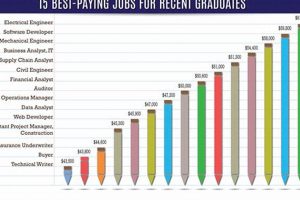Top-tier institutions offering industrial design programs provide rigorous training in design thinking, product development, manufacturing processes, and computer-aided design. These programs often incorporate hands-on studio experiences, collaborative projects, and internships with leading companies. Graduates emerge equipped to create innovative, functional, and aesthetically pleasing products for diverse markets.
A strong educational foundation in this field is critical for professionals seeking to shape the future of product design. Skilled industrial designers are in high demand across various industries, from consumer electronics and furniture to automotive and medical devices. The discipline has evolved significantly throughout history, influenced by movements like Bauhaus and the rise of mass production. Today, sustainability, user-centered design, and emerging technologies play increasingly important roles.
This article will explore key factors to consider when selecting an industrial design program, including curriculum, faculty expertise, facilities, and career resources. It will also delve into prominent institutions known for their excellence in this field, examining their unique strengths and specializations. Furthermore, the evolving landscape of industrial design, encompassing emerging trends and career pathways, will be discussed.
Tips for Selecting a Top Industrial Design Program
Choosing the right educational path is crucial for aspiring industrial designers. The following tips offer guidance for navigating the selection process and identifying programs best suited to individual career goals.
Tip 1: Evaluate Curriculum Depth and Breadth: Examine program curricula for a balance of theoretical knowledge and practical skills. Look for courses covering design thinking, sketching, 3D modeling, prototyping, materials science, and manufacturing processes.
Tip 2: Assess Faculty Expertise and Industry Connections: Research the faculty’s professional experience and industry connections. Faculty with practical experience and industry ties can provide valuable insights and networking opportunities.
Tip 3: Investigate Facilities and Resources: Modern workshops, studios, and access to advanced software and equipment are essential for hands-on learning. Tour facilities and inquire about available resources.
Tip 4: Consider Program Focus and Specializations: Some programs specialize in specific areas like transportation design, furniture design, or user interface/user experience (UI/UX). Align program focus with career aspirations.
Tip 5: Explore Career Services and Alumni Networks: Strong career services and active alumni networks can significantly impact post-graduation opportunities. Inquire about placement rates, internship opportunities, and alumni engagement.
Tip 6: Research Location and Culture: Consider the program’s location and its surrounding design community. A vibrant design scene can provide networking opportunities and exposure to industry trends.
Tip 7: Review Accreditation and Rankings: Program accreditation ensures quality and adherence to industry standards. While rankings offer a general overview, focus on program-specific strengths and alignment with personal goals.
Careful consideration of these factors will empower prospective students to make informed decisions and select programs aligned with their individual needs and ambitions. This careful selection process increases the likelihood of a successful and fulfilling career in industrial design.
By understanding these key elements and applying them to the program selection process, individuals can pave the way for a rewarding career in the dynamic field of industrial design. The next section will conclude this exploration with a look at the future of the profession.
1. Reputable Programs
A strong correlation exists between reputable programs and institutions considered the best for industrial design. Reputable programs typically exhibit several key characteristics: rigorous curricula, distinguished faculty, state-of-the-art facilities, strong industry connections, and successful alumni networks. These elements contribute significantly to a comprehensive education and enhance career prospects for graduates. The rigorous curriculum often combines theoretical foundations with practical application, fostering a deep understanding of design principles and manufacturing processes. Distinguished faculty, often recognized experts in their respective fields, provide mentorship and guidance, enriching the learning experience. State-of-the-art facilities provide access to cutting-edge technologies and resources, enabling students to develop and refine their skills. For instance, a reputable program might offer specialized workshops on advanced 3D printing techniques or access to sophisticated CAD software.
Furthermore, strong industry connections facilitate internships and collaborative projects, providing invaluable real-world experience and networking opportunities. A program with established ties to leading design firms might offer students the chance to work on live projects or participate in design competitions judged by industry professionals. Successful alumni networks also contribute to a program’s reputation, demonstrating the long-term impact of the education provided. The success of graduates in securing prominent positions within the industry serves as a testament to the program’s quality and effectiveness. These interconnected factors contribute to the overall reputation of a program, making it a significant factor in determining the “best” institutions for industrial design.
In conclusion, the reputation of a program serves as a reliable indicator of its quality and potential to prepare students for successful careers in industrial design. While other factors, such as location and individual learning styles, play a role in the selection process, the reputation of a program, built upon a foundation of academic rigor, experienced faculty, and industry connections, remains a critical consideration. Understanding this connection provides prospective students with valuable insights to make informed decisions when choosing an institution to pursue their design aspirations.
2. Experienced Faculty
A strong correlation exists between experienced faculty and institutions recognized for excellence in industrial design. Faculty expertise significantly influences the quality of education, student development, and overall program prestige. Experienced educators bring a wealth of practical knowledge, industry insights, and established networks, enriching the learning environment and fostering student success. Their contributions extend beyond theoretical instruction, encompassing mentorship, portfolio development guidance, and career advice.
For instance, faculty with prior experience in automotive design can provide students with invaluable insights into the complexities of vehicle development, from initial concept sketching to final production. This practical knowledge, gained through real-world projects, complements theoretical coursework, bridging the gap between academic learning and professional practice. Furthermore, experienced faculty often maintain active connections within the industry, facilitating internships, collaborative projects, and networking opportunities for students. These connections can prove invaluable in launching graduates’ careers and providing access to cutting-edge industry trends and technologies. For example, a faculty member with established ties to a leading design firm might arrange for student internships or guest lectures by industry professionals, exposing students to current practices and fostering valuable connections.
In summary, experienced faculty are integral to the success of top industrial design programs. Their practical expertise, industry connections, and mentorship significantly enhance the educational experience, preparing students for the demands of the profession. This connection underscores the importance of considering faculty experience when evaluating industrial design programs. Prospective students should research faculty backgrounds, industry involvement, and teaching philosophies to gain a comprehensive understanding of a program’s strengths and potential to support their career aspirations. This informed approach empowers individuals to make strategic decisions aligned with their educational and professional goals.
3. Advanced Facilities
A strong correlation exists between access to advanced facilities and the quality of industrial design education. Leading institutions prioritize providing students with state-of-the-art resources, recognizing their crucial role in fostering creativity, technical proficiency, and practical experience. These facilities often include well-equipped workshops for prototyping, advanced 3D printing labs, digital fabrication tools, and cutting-edge software suites. Access to such resources allows students to explore complex design challenges, experiment with diverse materials and manufacturing processes, and develop sophisticated prototypes that closely resemble final products. This hands-on experience bridges the gap between theoretical knowledge and practical application, essential for success in the field. For example, access to high-resolution 3D printers enables students to create intricate models with fine details, crucial for evaluating ergonomic considerations and aesthetic qualities. Similarly, availability of laser cutters and CNC machines allows for precise fabrication of complex components, facilitating the development of functional prototypes for testing and refinement.
Furthermore, advanced facilities foster collaboration and interdisciplinary learning. Shared studio spaces equipped with collaborative design software encourage teamwork and knowledge exchange among students. This collaborative environment mirrors professional design settings, preparing graduates for the dynamics of working within design teams. For instance, institutions may offer dedicated spaces for virtual reality (VR) and augmented reality (AR) design, enabling students to explore immersive design experiences and develop innovative human-computer interaction solutions. Access to these emerging technologies positions graduates at the forefront of the field, equipping them with skills highly sought after by industry.
In conclusion, investment in advanced facilities serves as a key indicator of an institution’s commitment to providing high-quality industrial design education. These resources play a critical role in nurturing creativity, technical proficiency, and collaborative skills, essential for success in the demanding field of industrial design. Prospective students should carefully evaluate the facilities available at different institutions, recognizing their direct impact on learning outcomes and career preparedness. This understanding empowers informed decision-making and increases the likelihood of selecting a program aligned with individual aspirations and professional goals.
4. Industry Connections
Strong industry connections are a hallmark of leading industrial design programs. These connections provide invaluable benefits to students, enriching their educational experience and significantly enhancing career prospects. Collaboration with industry partners offers real-world context, practical skills development, and access to professional networks, crucial for success in this competitive field.
- Internship Opportunities:
Partnerships with established design firms, manufacturing companies, and consultancies create a pipeline for internships. These experiences provide students with practical application of classroom learning, exposure to industry workflows, and opportunities to build professional portfolios. For example, an internship with a furniture design company might involve assisting with design research, prototyping, or even contributing to a product launch. Such experiences significantly enhance a graduate’s employability.
- Guest Lectures and Workshops:
Industry professionals frequently contribute to academic programs through guest lectures, workshops, and portfolio reviews. These interactions offer students insights into current industry trends, emerging technologies, and professional best practices. A workshop on sustainable materials led by a leading materials scientist, for example, provides students with specialized knowledge highly relevant to contemporary design challenges.
- Collaborative Projects and Competitions:
Industry-sponsored projects and design competitions offer students opportunities to work on real-world briefs, tackle complex design challenges, and gain recognition for their creative solutions. Participating in a competition sponsored by a major automotive manufacturer, for instance, allows students to apply their skills in a competitive setting and potentially gain exposure to industry leaders.
- Career Placement and Networking:
Strong industry connections often translate into enhanced career services and networking opportunities. Institutions with established industry partnerships may facilitate career fairs, recruitment events, and alumni networking sessions, providing graduates with a direct pathway to employment opportunities. These connections significantly shorten the job search process and increase the likelihood of securing desirable positions upon graduation.
In summary, robust industry connections are a critical factor differentiating top industrial design programs. These connections serve as a bridge between academic learning and professional practice, providing students with the skills, experience, and networks essential for thriving in this dynamic field. When evaluating programs, prospective students should carefully consider the strength and breadth of industry partnerships, recognizing their direct impact on career trajectory and long-term success.
5. Career Support
Robust career support services are a defining characteristic of top industrial design programs. These services play a crucial role in bridging the gap between academic learning and professional practice, equipping graduates with the tools and resources necessary to navigate the competitive design landscape and launch successful careers. Effective career support encompasses a range of services tailored to the specific needs of design students, from portfolio development and internship placement to networking opportunities and job search strategies.
- Portfolio Development:
A compelling portfolio is essential for showcasing design skills and securing employment. Top programs offer dedicated portfolio development workshops, individual consultations with faculty, and access to professional printing and presentation resources. This support ensures graduates present their work effectively, highlighting their unique strengths and design sensibilities. For instance, workshops might focus on curating project selections, crafting compelling narratives, and optimizing digital portfolio presentation.
- Internship Placement:
Internships provide invaluable real-world experience and often serve as a stepping stone to full-time employment. Leading programs cultivate strong industry connections to facilitate internship placements with reputable design firms, manufacturers, and consultancies. These connections provide access to a diverse range of internship opportunities aligned with students’ specific career interests, whether in furniture design, product development, or user experience. A dedicated internship coordinator might connect students with companies seeking specific skillsets, increasing the likelihood of successful placements and subsequent career opportunities.
- Networking Opportunities:
Building a professional network is crucial for career advancement. Top programs organize career fairs, networking events, and alumni mentorship programs to connect students with industry professionals. These opportunities facilitate valuable connections, provide insights into different career paths, and often lead to job leads or mentorship relationships. For example, an alumni networking event might connect graduating students with established designers working in their desired field, fostering valuable mentorship relationships and potential job prospects.
- Job Search Strategies:
Navigating the job market requires strategic planning and effective self-promotion. Leading programs offer workshops on resume writing, interview skills, and online portfolio development. This support equips graduates with the tools and strategies necessary to present themselves effectively to potential employers and navigate the competitive job application process. Individualized career counseling might address specific job search challenges, tailoring strategies to individual career goals and skillsets. This personalized approach increases the likelihood of securing desirable positions and launching successful design careers.
In conclusion, comprehensive career support is a defining characteristic of leading industrial design programs. These services are instrumental in preparing graduates for the professional world, connecting them with industry opportunities, and empowering them to launch successful and fulfilling design careers. The strength of career support services is a key factor to consider when evaluating programs, as it directly impacts a graduate’s ability to transition smoothly from academia to professional practice and thrive in the dynamic field of industrial design.
Frequently Asked Questions
This section addresses common inquiries regarding the pursuit of industrial design education, aiming to provide clarity and guidance for prospective students.
Question 1: What distinguishes top industrial design programs from others?
Distinguished programs typically offer a combination of rigorous curricula, renowned faculty, state-of-the-art facilities, strong industry connections, and comprehensive career support services. These elements contribute to a well-rounded education and enhanced career prospects.
Question 2: How important is portfolio development for admission to competitive programs?
A strong portfolio showcasing creativity, technical skills, and design thinking is crucial for admission. It demonstrates an applicant’s potential and provides tangible evidence of their design abilities. Portfolios should ideally include a diverse range of projects, highlighting both individual and collaborative work.
Question 3: What career paths are available to industrial design graduates?
Graduates pursue diverse career paths, including product design, furniture design, transportation design, user interface/user experience (UI/UX) design, and design research. The specific path chosen often depends on individual interests, specialization within the program, and industry demand.
Question 4: What is the typical duration of an industrial design program?
Undergraduate programs typically require four years of full-time study, while graduate programs (Master of Fine Arts or Master of Design) typically span two to three years. Program duration may vary depending on the institution and specific program requirements.
Question 5: How can one research and compare different industrial design programs effectively?
Thorough research involves reviewing program websites, examining curriculum details, researching faculty expertise, investigating available resources, and connecting with current students or alumni. Attending virtual information sessions or campus visits also provides valuable insights.
Question 6: What role does accreditation play in selecting an industrial design program?
Programmatic accreditation by recognized bodies signifies adherence to established quality standards and industry best practices. Accreditation assures prospective students and employers of the program’s rigor and relevance to professional practice.
Careful consideration of these frequently asked questions empowers prospective students to make informed decisions aligned with individual career aspirations and educational goals. Understanding these key aspects facilitates a more effective program selection process, ultimately contributing to a successful and fulfilling career in industrial design.
This concludes the frequently asked questions section. The following section will offer a concluding perspective on the future of industrial design.
Conclusion
Selecting among top industrial design programs requires careful evaluation of several key factors. Rigorous curricula, experienced faculty, advanced facilities, strong industry connections, and comprehensive career support services collectively contribute to a well-rounded education and prepare graduates for successful careers. The foregoing exploration emphasized the significance of researching program reputations, examining faculty expertise, and considering available resources. Furthermore, understanding the role of industry partnerships and career services in shaping career trajectories is essential for informed decision-making.
The future of industrial design demands innovative thinkers capable of addressing complex societal challenges through human-centered design solutions. Choosing the right educational foundation is paramount for aspiring designers seeking to contribute meaningfully to this evolving field. Thorough research and careful consideration of individual needs and aspirations will empower prospective students to select the optimal program to cultivate their design talents and shape the future of product development and innovation.







